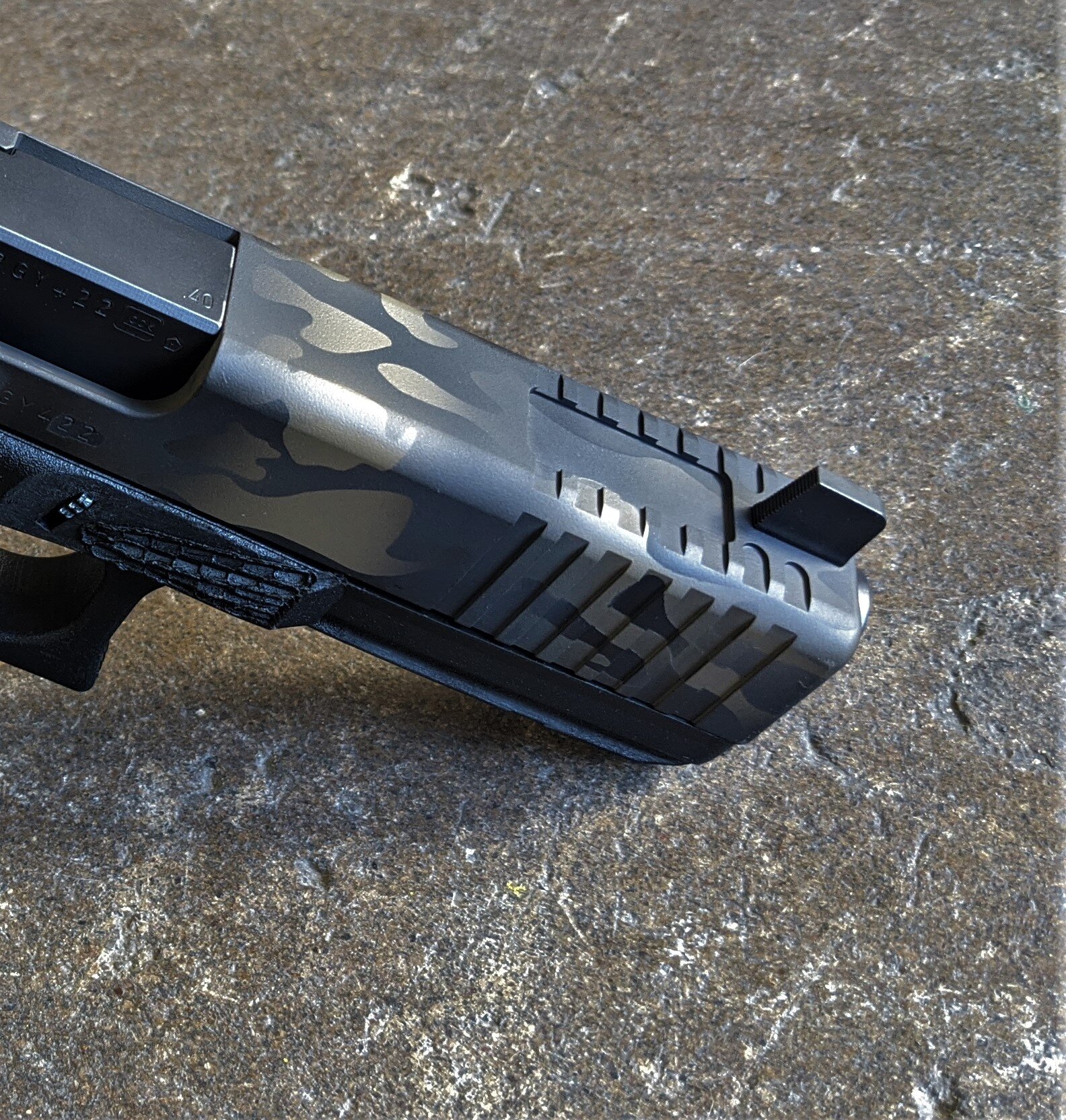Feat of the Week: Black Multi-Cam Glock 22
Welcome to our weekly blog post! Each “Feat of the Week” features firearm(s) we have worked on recently. These are showcases of our repair work, custom machining, Cerakote, or a combination of services. We are excited to share our gunsmithing feats with you!
This week’s gunsmithing feat is a Glock 22 with custom slide machining, a pistol optic cut, and a black multi-cam Cerakote job. Glocks never seem to need repair services, but they make up a lot of our custom machining and Cerakote work. We can’t wait to share more about this feat and about Glock’s history. So let’s get started!
Black Multi-Cam Glock 22
MAKE/MODEL: Third Generation Glock 22
CALIBER: .40 CaL
Finish: black multi-cam by McCluskey Arms
Optic from Trijicon with cut by mccluskey Arms
Custom Slide Serrations by Mccluskey Arms
Faux Window cut by McCluskey Arms
The Gunsmithing Story
About one-third of my gunsmithing services are repair jobs. But very rarely do I diagnose or fix Glocks. They just don’t break. They can last thousands and thousands of rounds without needing a gunsmith.
Glocks have a standard, almost boring look to them. To be fair, they’re designed for durability and mass production. People want Glocks for their familiarity and functionality but want customization services for enhanced aesthetic appeal and personalization. While our Glock-owning customers rarely spend money with us on repair, they sure do love our machining and Cerakote services. For example, almost half of my optic cuts are Glocks!
This customer brought his third generation Glock 22 to us. He wanted to customize his pistol with both slide machining and Cerakote. First, we machined forward slide serrations—a common service for many of our Glock-carrying customers. He also wanted a faux window cut on top of the slide. We had machined this cut only once before. He had seen the faux window cut we had done for our friend Justin—on the Splinter Cam Glock featured in our first ever Feat of the Week—and wanted it on his gun too.
Forward Slide Serrations and Faux Window Cut
Finally, to round out the machining work on this gun, we gave this Glock 22 an optic cut. As we said in a recent blog post, optic cuts are hot right now! Everyone seems to want one—especially Glock owners.
The Cerakote Story
To fully customize his pistol, the customer wanted a black multi-cam Cerakote paint job. MultiCam—a trademarked name—from Crye Precision was a camouflage developed in 2002 to be used by the U.S. military in multiple environments throughout the various seasons and even during different times of the day. The designers created the pattern to trick the brain into “filling-in” the pattern as part of the background—blending the wearer into the surroundings.
Instead of choosing MultiCam, though, the Army decided to adopt UCP—which stands for universal camouflage pattern—for their forces. But in 2010, MultiCam was commissioned by the Army for use in Afghanistan. Currently, it is worn by special operations forces, the DEA, ICE, and various SWAT teams around the country.
There are four patterns of MultiCam: 1) arid for the desert, 2) tropic for dense vegetation, 3) alpine for environments with heavy snow, and 4) black for use by law enforcement for “authoritative presence” in “high-risk environments”.
This customer chose the black multi-cam pattern for his Glock 22. While standard MultiCam uses seven colors, our paint job only used four. But we think it still turned out amazing! And much less expensive than a seven coat paint job.
Black MultiCam is quite fitting for a Glock. Because the pattern is built for law enforcement purposes and the Glock is one of the most widely used pistols among police forces in the United States—with 65% of agencies issuing Glocks as a service pistol—there couldn’t have been a better camouflaged.
The Glock’s History
In addition to police forces, militaries around the world issue Glocks to their personnel. And, in the civilian market, it seems everyone has at least one Glock. Their popularity exploded in the 1990s with the adoption by several militaries but also with their rise in pop culture—appearing in popular shows like Law and Order, movies like Bruce Willis’ Die Hard 2, and famous rap songs from Dr. Dre and Tupac. With pop culture appearances and widespread military and police use, the Glock gained more recognition throughout the world.
Indeed, it is one of the most recognizable guns in the world today. It is the most prolific handgun of the modern era. It is the 1911 of our time and the AK of pistols. Just as people use “Kleenex” as a synonym for tissue, some use “Glock” as a synonym for pistol.
Ironically, the creator of the Glock pistol, Gaston Glock, was not a firearms designer or gunsmith. In fact, he wasn’t even involved in the gun industry, and the Glock 17 was his first ever firearm creation.
His company, founded in Austria in 1963, produced consumer goods from polymers, wood, and metal. In the 1970s, Glock began producing products for the military including knives, grenade casings, and machine gun belt links.
More importantly, the company specialized in producing plastic products. Gaston Glock invented “Polymer 2” which is a nylon-based, high-strength polymer resistant to shock and extreme temperatures. This plastic product is durable and resilient—more than most steel alloys and carbon steel. And, in 1980, the company purchased a new machine to injection mold polymer handles and sheathes. It was this machine that allowed him to manufacture the first polymer-frame Glock 17 pistol.
When the Austrian military sought to replace their Walter P38 sidearm, Glock set out to create a pistol out of his advanced synthetic polymer. In just three months, Glock and his team created a prototype fulfilling all the requirements. The pistol submitted was the 17th patent and thus became known as the Glock 17.
The pistol could fire 15,000 rounds without significant wear, was much lighter than other pistols, and was also drop-proof from two meters. It out performed all other guns submitted to the Austrian military, and with the use of polymers and modern manufacturing techniques, the Glock 17 was also the most cost-effective option.
Glock 17 used by the Norwegian military under the P80 designation
By Askild Antonsen - Glock 17, CC BY 2.0, https://commons.wikimedia.org/w/index.php?curid=82534411
Glock earned his first contract of 25,000 guns with the Austrian military and police in 1982 after beating out eight other pistols—including guns from giants like Heckler & Kock, Sig Saur, Beretta, and FN. After Glock earned the Austrian contract, the plastic pistol caught the eye of the United States military who was seeking to replace the M1911. While the United States chose to go with the Beretta instead, Glock had undergone successful trials in Norway and Sweden. After being adopted by both of those militaries, the Glock 17 became a NATO classified gun.
Though it wasn’t the first plastic gun, the Glock 17 was the first widely used polymer-framed pistol. When it first came to market, people had many doubts. But very quickly Glock established a reputation as a reliable and durable product.
But it wasn’t only the plastic frame which made the Glock groundbreaking. It was also the three internal safeties which prevented accidental or negligent discharges. The trigger on a Glock has some responsibility in cocking the striker. This means, unlike other guns, that the shooter’s finger aids the recoil spring to cock the striker making the pistol more reliable in the long term. Additionally, Glocks are incredibly simple guns with an average of thirty-five parts—much fewer than most other handguns—and all of which are interchangeable (except Gen5 Glocks).
In the years since the first Glock 17, the company consistently produced new generations of their various models. Each made small changes adding accessory options, ambidextrous abilities, or ergonomic updates. While some alterations were made to the pistols, the general design and operation remained the same. This is a huge benefit to military and police for training purposes. Purchasing an updated Glock doesn’t require additional training as everything remains the same. Glock has found what works and has stuck to it.
I need to confess that I am a huge Glock fan so I’m a little biased. I consider myself to be a Glock collector. I even have a rare third generation Glock 21SF with an all-time ambidextrous magazine release and picatinny rail. Though some people have reported issues with this gun, mine has always worked great!
I also have a Glock for my EDC and speed shooting competitions. But most recently, I acquired a Glock 44. It’s the gun that I use most at the range these days. With COVID 9mm shortages and the cheapness of .22, I love shooting my Glock 44. It allows me to train for speed steel without wasting precious 9mm.
After thousands of rounds through each pistol, I’ve never had to do one bit of repair gunsmithing on any of my Glocks. Unfortunately, I’ve also never done any custom machining or Cerakote on my own Glocks. This customer’s Glock 22 is way cooler than any of mine.
NEXT UP
We hope you enjoyed this week’s gunsmithing feat. Thank you for following along! Our next feature will be posted Monday, November 23rd at 9am. Comment for any content you want to see.
If you loved the services you saw today, check out our online store! You can start shopping by clicking here. Or drop us a message here. And don’t forget to follow us on social media! We look forward to meeting you and gunsmithing for you
Sources:
https://multicampattern.com/multicam_patterns/
http://www.camopedia.org/index.php?title=Multicam
https://en.wikipedia.org/wiki/MultiCam
https://us.glock.com/en/LEARN/Brand/History
https://www.popularmechanics.com/military/weapons/a7445/why-the-glock-became-americas-handgun/
https://en.wikipedia.org/wiki/Glock





